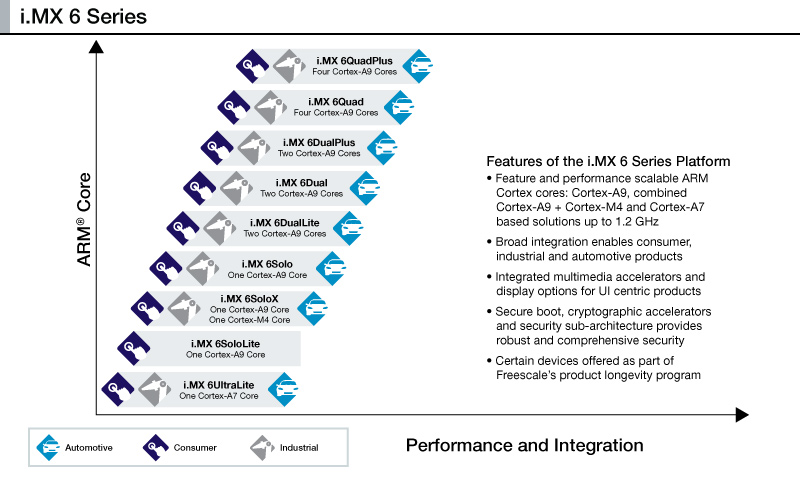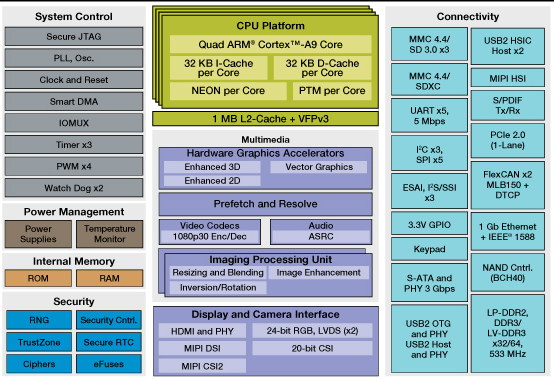Freescale unveiled three new models for its i.MX 6 family processor for consumer, industrial and automotive markets in May. Two models are an upgrade to existing i.MX6 Quad and i.MX6 Dual processors, as the new i.MX 6QuadPlus and i.MX6DualPlus processors features four and two Cortex A9 cores, together with improved 2D and 3D GPUs delivering around 50% faster performance, an “optimized” SDRAM controller, more SRAM, and a prefetch and resolve engine. The third model, i.MX 6UltraLite, features a single ARM Cortex A7 core and hardware security, and targets applications such as electronic Point Of Sales (ePOS).

That means there are now 9 i.MX6 processors, and today, I’ll focus on the two new “Plus” versions. Since they are based on the original i.MX6 Quad and i.MX6 Dual processors, the best way to have a look at these is to compare them to their predecessors.
| Features | i.MX 6QuadPlus | i.MX 6Quad | i.MX 6DualPlus | i.MX 6Dual |
| CPU | 4x ARM Cortex A9 up to 1.2GHz | 2x ARM Cortex A9 up to 1.2GHz | ||
| I-Cache/D-Cache | 32KB/32KB L1, 1MB L2 | |||
| Embedded SRAM | 512KB | 256KB | 512KB | 256KB |
| Memory Interface | 2x 32 LP-DDR2, 1-ch, x 64 DDR3/LV-DDR3, Page and Channel Interleaving at 533 MHz | |||
| Hardware Video Acceleration | Open GL ES 1.1/2.0/3.0 OpenCL 1.1 EP OpenVG 1.1, 2DBLT, 8 layer composition, 4 shaders, 720 MHz, embedded prefetch and resolve engine |
Open GL ES 1.1/2.0/3.0 OpenCL 1.1 EP OpenVG 1.1, 2DBLT, 2 layer composition, 4 shaders, 594 MHz |
Open GL ES 1.1/2.0/3.0 OpenCL 1.1 EP OpenVG 1.1, 2DBLT, 8 layer composition, 4 shaders, 720 MHz, embedded prefetch and resolve engine |
Open GL ES 1.1/2.0/3.0 OpenCL 1.1 EP OpenVG 1.1, 2DBLT, 2 layer composition, 4 shaders, 594 MHz |
| Package | 21 x 21 BGA 0.8mm | |||
So we can see the SRAM doubled, GPU improvements include a faster shader frequency (720 MHz vs 594 MHz), and 8-layer composition support instead of just two, and the prefetch and resolve engine. Strangely the “newly optimized 64-bit DDR3/LVDDR3/LPDDR2-1066 memory interface to increase bus bandwidth ” is not reflected in this table, and the company did not name Vivante has the GPU vendor. The good news is that the news parts use the same package, and actually pin-to-pin compatible, meaning in due time we may see Wandboard Quad Plus or UDOO Quad Plus or other boards and products coming to market.

All other features and peripherals are identical including video playback capabilities, Gigabit Ethernet, SATA, low speed I/Os, and so one. The data in this table has been extracted from Freescale’s i.MX 6 Series Comparison Table.
Freescale posted a video comparing the 2D and 3D graphics performance of i.MX 6QuadPlus against i.MX 6Quad with a memory bandwidth, fractal, texture and 8-layer composition demos, indeed showing significant performance improvement in the order of 50% to over 100%.
i.MX 6DualPlus and i.MX 6QuadPlus processors have been sampling since May, but mass production is only planned for October 2015, while i.MX 6UltraLite processor must have started sampling in July 2015, with no date announced for production. More information should soon be available on Freescale i.MX6 product page.
Thanks to Nanik.

Jean-Luc started CNX Software in 2010 as a part-time endeavor, before quitting his job as a software engineering manager, and starting to write daily news, and reviews full time later in 2011.
Support CNX Software! Donate via cryptocurrencies, become a Patron on Patreon, or purchase goods on Amazon or Aliexpress




